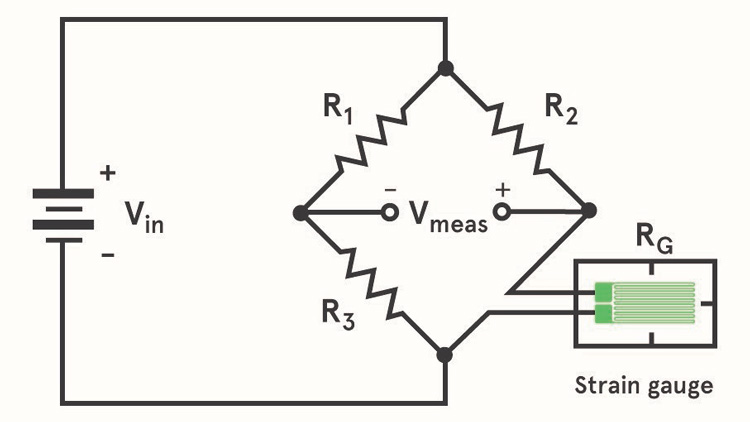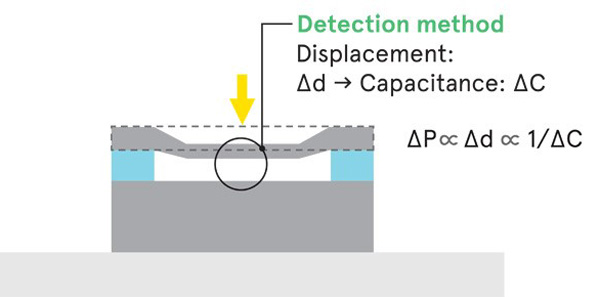A quick guide to choosing a pressure sensor
When considering what type of pressure sensor is best suited for your industrial application, it may be an overwhelming experience looking at the sheer number of different choices available. Here’s a quick breakdown of the different pressure sensor technologies available and key pressure sensor attributes that should help you decide.
Guest blog by Martin Keenan, Technical Director, Avnet Abacus.
There are a few different designs available, though most are based on strain gauges. Strain gauges are usually a filament of metal foil attached to a diaphragm of a particular material. Under pressure, the diaphragm deflects, stretching the foil filament, whose change in resistance is measured and the pressure is deduced from that. Usually four filaments are placed on the diaphragm and connected in a Wheatstone bridge arrangement for accurate measurement of their resistance.

An example of a Wheatstone bridge circuit used in strain gauges
Gluing or bonding the filaments onto the metal diaphragm is the most common technique, and these sensors are popular as they have a wide measurement range and can deal with reasonably high temperatures. Sputtering the filaments onto a glass diaphragm is another way of doing it, which attaches the metal at the molecular level, meaning they are one of the most robust types on the market. Pressure sensors on chips for the mass market use a silicon MEMS diaphragm with a strain gauge device grown onto it – it’s the same principle, but they can be integrated easily into commonly used MEMS packages and/or alongside other sensors and signal conditioning electronics.
There are also pressure sensors that detect the deflection of a metal diaphragm by measuring the change in capacitance between the diaphragm and another metal surface, though these are sometimes sensitive to high temperatures. Some strain gauges use quartz or tourmaline, materials that produce electrical energy when subject to strain: these measure changes in pressure and they are not suitable for applications subject to shock and vibration.
 Schematic illustration of a capacitive element
Schematic illustration of a capacitive element
Key pressure sensor attributes for comparison include measurement range. Consider the range of pressures you expect the sensor to experience in normal operation and the range you want to measure and compare these figures with what’s listed in the sensor’s data sheets. The sensor may also have a proof pressure, the maximum pressure it can withstand and still work, and burst pressure, the pressure level that will burst the diaphragm so fluids can leak through. The most sensitive sensors generally have low proof pressures and burst pressures, so choosing the right part may be a trade off between these criteria.
Pressure sensors’ accuracy is often given as a percentage of full scale over a certain temperature range. In real life, there are many different components of accuracy, including linearity, hysteresis and repeatability, which can be found in the data sheets, if appropriate.
Stability, the ability to retain consistent performance over time, will also probably be a desirable attribute. Sensors that are particularly unstable may be reset to zero using an algorithm, but they may require removing the sensor from the application (and the applied pressure) to calibrate, which may or may not be convenient. Temperature changes can affect the zero offset pressure and full scale span of the sensor, too.
Accuracy and stability may be represented by TEB (total error band) figures, a combination of all the possible errors for that sensor, including accuracy, stability and temperature effects. Note that accuracy is only a part of the TEB, so these figures shouldn’t be directly compared for different sensors.
The environment the sensor will be used in also has a big influence on selection. Aside from the pressure range, what will the operating temperature range be? Will the sensor experience shock and vibration? If so, a mechanically robust design is best. Will an atmospheric pressure sensor potentially be exposed to liquids or contaminants? This could be a problem, as most have an air vent in the packaging. Specialist sensors are available for heavy-duty applications such as transportation, highly accurate applications such as medical equipment, and low cost applications such as consumer devices.
The final question to ask is: what resources do I have to dedicate to integrating this sensor into my system? Some sensors come with the signal conditioning electronics, temperature compensation and internal diagnostic functionality already integrated into their packaging for quick and easy design-in. If you have specialist requirements in terms of performance, and you have the expertise, time and budget, your project may be better suited to a custom design for the sensor’s electronics. Note that if you go down this route, the sensor will likely require calibration after assembly.
While there are other secondary parameters for consideration (response time, energy efficiency, and packaging size/form factor, etc.) the factors listed here are a good starting point.
To find out more about pressure sensors visit the Avnet Abacus website, here.







